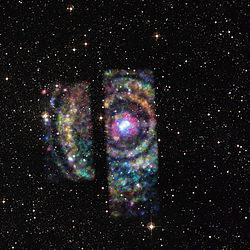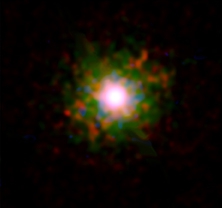Circinus X-1
| Observation data J2000
| ||
|---|---|---|
| Constellation | Circinus | |
| Right ascension | 15h 20m 40.85s[1] | |
| Declination | −57° 10′ 00.1″[1] | |
| Apparent magnitude (V) | 21.40[2] | |
| Characteristics | ||
| Spectral type | B5–A0 I[3] | |
| Variable type | HMXB[4]
| |
Semi-amplitude (K1)(primary) | 25 ± 2 km/s | |
| Database references | ||
| SIMBAD | data | |
Circinus X-1 is an X-ray binary star system that includes a neutron star. Observation of Circinus X-1 in July 2007 revealed the presence of X-ray jets normally found in black hole systems; it is the first of the sort to be discovered that displays this similarity to black holes. Circinus X-1 may be among the youngest X-ray binaries observed.
Location, distance
On June 14, 1969, an
On June 23, 2015, an article published on NASA's Chandra X-Ray Observatory's website, revealed that an international team of astronomers has succeeded in determining its distance from Earth with more precision - via a method of triangulation of X-ray light emitted by the star, echoing through stellar clouds and interstellar dust - as being about 30,700 light-years.[9]
A 16.6 day X-ray period was found by Kaluzienski et al.[10] The X-ray source is assumed to be a neutron star as part of a low-mass X-ray binary (LMXB), type-I X-ray burster.[11] The X-ray and radio nebulae surrounding Circinus X-1 have properties consistent with a young supernova remnant. This rare case of an X-ray binary apparently associated with a supernova remnant suggests the binary is very young on cosmic time scales, possibly less than 4600 years old.[12] An association of Circinus X-1 with a different nearby supernova remnant, G321.9-0.3, has been ruled out.[11]

Other spectral regions
The binary nature of Cir X-1 has been established.[13] The binary's radio component and a possible visual counterpart were identified by Whelan et al.[14] Its infrared counterpart was located and found to flare with a 16.6-day period by Glass.[15] A (heavily reddened) precise optical counterpart (now known as BR Cir) was identified by Moneti.[16]
References
- ^ S2CID 115529446.
- S2CID 14673570.
- ^ S2CID 7474465.
- ^ a b "V* BR Cir". SIMBAD. Centre de données astronomiques de Strasbourg. Retrieved 22 September 2017.
- S2CID 17657655.
- hdl:2060/19710026671.
- S2CID 18973228.
- ^ "Circinus X-1: Neutron Stars Join The Black Hole Jet Set". Harvard-Smithsonian Center for Astrophysics. Retrieved 5 December 2013.
- ^ "NASA's Chandra Captures X-Ray Echoes Pinpointing Distant Neutron Star". 23 June 2015. Retrieved 24 June 2015.
- doi:10.1086/182235.
- ^ S2CID 18606269.
- S2CID 6064052.
- Bibcode:1973BAAS....5..395J.
- .
- .
- Bibcode:1992A&A...260L...7M.
- "Circinus X-1: Neutron Stars Join the Black Hole Set". National Aeronautics and Space Administration. 2007. Retrieved 8 January 2009.

